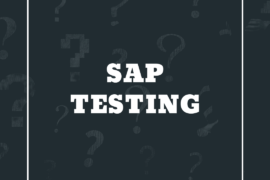When we think about the activities that must be planned and performed within an SAP project, the Data Migration activity, without a doubt, is one of the most critical and important activities of any project.
Generally, when the time is not invested in this important task, the results can be catastrophic.
What is Data Migration?
Basically, in a simplistic way, when we talk about data migration, we are talking about the act of loading data (either from another system or another version of SAP) into an SAP environment.
Defining it this way, it seems to be something extremely simple, but it is not.
The migration activity is usually initiated in conjunction with the project’s Kick-Off, as the tasks to be carried out for successful data migration are usually laborious and time-consuming.
Data Migration Stages
Simplistically, we can divide the migration phase as follows:
- Creation of a spreadsheet of objects that can be migrated (suppliers, customers, purchase orders, sales orders, etc.).
- Definition of which objects will be in the scope of migration.
- Assignment of a Key User to be responsible for each object.
- Assignment of an SAP Consultant to provide assistance and guidance to the Key User.
- Definition if that particular object will be loaded into the system automatically (using loading programs) or manually (created by the business team itself).
- Definition of the amount of data loads to be performed (generally, at least 2 test loads and one final load are performed in the Production environment).
Of course, there are more steps, but the steps above can already give you an idea of the complexity of this very important activity.
Even depending on the size and complexity of the project, an entire team of consultants can be allocated only to carry out this activity.
Main Challenges
The main challenges that are usually faced by the data migration team are:
- High volume of information (which generates a great deal of work for the business team, as the data must be checked one by one so that no waste is loaded into the system).
- Data extraction from the legacy system (especially when the previous system is not an SAP environment, the data structure can be totally different from what SAP expects and this results in an almost manual construction of the load file).
- Fields that do not exist in the data loading programs used by the global team (depending on the tax complexity of the country where the project is being executed, SAP usually offers new fields for tax information to be stored in the system and in these cases, usually the loading programs need to be redone, which creates a lot of work for the project consultants).
- Overwork for Key Users and Consultants (In many projects, both Key Users and Consultants are responsible for both defining processes and data. This tends to create great stress on those involved, in addition to increasing the risk for the activity, compromising data quality).
Tools
Depending on the project and the client itself, the tools for the data migration activity can vary widely.
Of course, 99% of the time Excel is used as a source of information, that is, each object to be loaded, has an Excel file (with several tabs) and it is worked on by Key Users until they are ready to be delivered to the Data Migration team to load the SAP.
In addition to Excel, some companies can use more advanced tools, or even developed by the company itself.
Thinking on the data load side, SAP offers several tools for loading, the main ones being:
- LSMW
- SAP Data Services
- SAP Migration Cockpit
Risks
Do you know what is the main risk when we have a data load strategy implemented with low quality?
The risk of having a terrible Go Live.
The data within the SAP system is one of the main pillars for the correct functioning of any process (be it purchasing, sales, production, quality, etc.).
Imagine the following scenario:
His company is a leading pharmaceutical company that produces highly complex drugs for the treatment of degenerative diseases.
In the past, you used another ERP system (Oracle for example), and the project to implement the SAP system was completed 2 months ago.
Even the project was a success, it was delivered on time and without headaches.
To deliver the project on time, a great effort was made by everyone, but the Data Migration activity was done without due attention and the data quality was average.
The quality team requested the purchase of a dangerous material (which must be controlled by law), that is, when the material is received by the company, it must be blocked in the system so that it can be analyzed by the quality team and an issue is issued. Certificate of Analysis for the material.
Unfortunately, the registration of this material was carried out without the vision of quality.
And what does that imply?
From the moment it is received in the system, it is available in the system for use or even a possible sale.
And what happened?
The material arrived, was received in the system, and then used (without issuing the certificate of analysis).
Unfortunately, that same day, a government official appeared and said he would perform a surprise audit.
The company was fined.
What was the root cause?
Data Load Problem.
This was simply one of the examples that a load of poor quality data can generate. There are several others. The list is huge.
Conclusion
I hope that you have managed to get a good view of this very important activity within an SAP project and how critical it is.
I leave it as a suggestion to always give due priority to this activity, including people dedicated to ensuring the quality of the data throughout the process.
If you liked this post, be sure to subscribe to our newsletter to receive first hand the next posts.
If you have any suggestions (including subjects you would like to read about), feel free to send an email to sapsteps@sapsteps.com.
A big hug,
Bruno César



